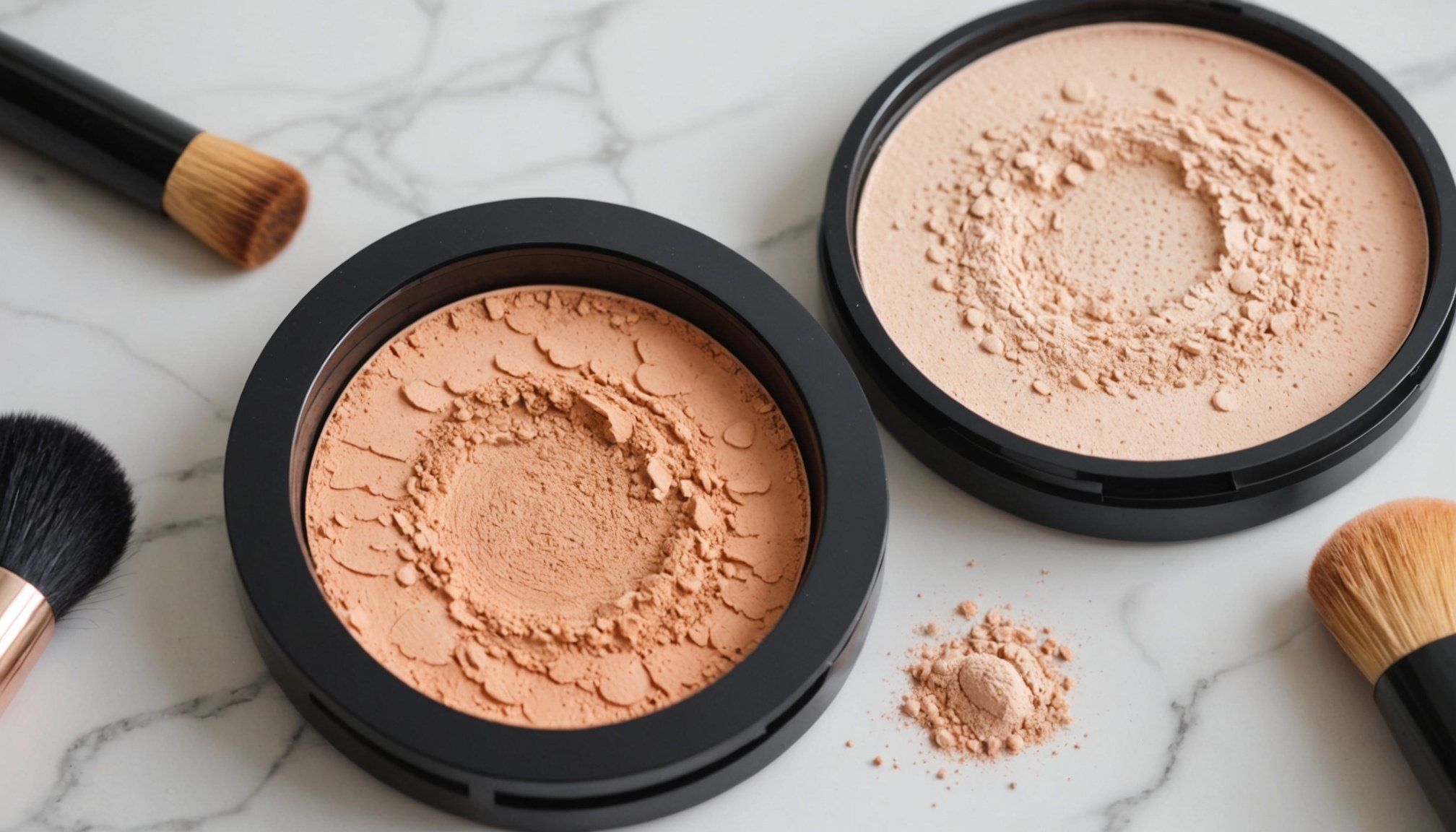Setting Powder vs. Setting Spray: Which Ensures Your Makeup Lasts Longer? Uncover the Benefits and Drawbacks!
When it comes to keeping your makeup looking flawless and long-lasting, two products often come to mind: setting powder and setting spray. Both are designed to help your makeup stay in place, but they work in different ways and have distinct benefits and drawbacks. In this article, we’ll delve into the details of each product, helping you decide which one is best for your beauty routine.
Understanding Setting Powder
Setting powder is a staple in many makeup bags, and for good reason. Here’s what you need to know about this versatile product.
Have you seen this : Top Vegan Skincare Solutions to Fight Winter Dryness: Your Ultimate Guide
What is Setting Powder?
Setting powder is used to extend the longevity of your makeup. It absorbs excess oils from your skin and liquid foundation, preventing your makeup from becoming oily or smudged throughout the day. As Kathy Zikas, lead makeup artist and co-founder of Curled + Contoured, explains, “Setting powder’s purpose is to hold makeup on all day and night. This powder soaks up excess oils in the skin as well as in liquid foundation products in order to hold liquid makeup on for a longer amount of time.”[1].
How to Use Setting Powder
To use setting powder effectively, apply it on top of your liquid foundation and concealer. This helps lock these wet products into place, preventing them from transferring to other surfaces. Here are some tips for applying setting powder:
Additional reading : Transform Your Beauty Regimen: Discover the Benefits of Natural Rosewater in the UK
- Choose the Right Brush: Use a flat-top brush or a domed powder brush, depending on your personal preference.
- Apply Lightly: Gently dust the powder onto your brush and then stamp and pat it across your face.
- Focus on Oily Areas: Pay extra attention to areas prone to oiliness, such as the T-zone.
Benefits of Setting Powder
- Long-Lasting Makeup: Setting powder ensures your makeup stays in place for hours without the need for frequent touch-ups.
- Oil Control: It absorbs excess oils, making it a must-have for those with oily skin.
- Versatility: Setting powder can be layered multiple times to control oil throughout the day without showing a white cast or reacting poorly with cameras[1].
Drawbacks of Setting Powder
- Caking: If applied too heavily, setting powder can cake up and settle into lines or wrinkles.
- Dry Skin: While setting powder is beneficial for oily skin, it can exacerbate dry skin if not used sparingly.
Understanding Setting Spray
Setting spray is another popular choice for keeping your makeup in place, but it works differently from setting powder.
What is Setting Spray?
Setting spray is a finishing product designed to lock your entire makeup look in place. It ensures that your makeup lasts all day without fading, smudging, or creasing. According to the BeautyBlender blog, “A makeup setting spray is a finishing product designed to lock your makeup in place, ensuring it lasts all day without fading, smudging, or creasing.”[2].
How to Use Setting Spray
Using setting spray is straightforward:
- Spray After Makeup Application: Once you’ve completed your makeup look, hold the can 6-8 inches away from your face and spray a light mist evenly over your face.
- Let it Set: Allow the spray to dry completely before touching your face.
Benefits of Setting Spray
- All-Day Hold: Setting spray provides a strong hold that keeps your makeup intact throughout the day.
- Easy to Use: It’s quick and easy to apply, making it a great option for those in a hurry.
- Suitable for All Skin Types: Setting sprays are generally suitable for all skin types, including oily, dry, and combination skin.
Drawbacks of Setting Spray
- Less Oil Control: Unlike setting powder, setting spray does not absorb excess oils, so it may not be as effective for very oily skin.
- Limited Layering: You can’t layer setting spray multiple times without risking a sticky or heavy feel.
Comparing Setting Powder and Setting Spray
To help you make an informed decision, here’s a detailed comparison of setting powder and setting spray.
Key Differences
| Feature | Setting Powder | Setting Spray |
|---|---|---|
| Primary Function | Absorbs excess oils and sets makeup in place | Locks entire makeup look in place |
| Application Method | Applied with a brush after liquid foundation and concealer | Sprayed evenly over the face after completing makeup |
| Oil Control | Excellent oil control, especially for oily skin | Limited oil control |
| Layering | Can be layered multiple times to control oil | Generally not recommended to layer multiple times |
| Suitable Skin Types | Best for oily skin, can be used on dry skin with caution | Suitable for all skin types |
| Finish | Can provide a matte finish or translucent look depending on the type | Typically provides a natural, non-greasy finish |
| Price | Varies widely, but generally affordable | Varies, but often priced similarly to setting powders |
| Common Issues | Can cake up if applied too heavily | Can feel sticky if layered too much |
Practical Insights and Actionable Advice
Here are some practical tips to help you integrate these products into your makeup routine effectively:
For Oily Skin:
- Use Setting Powder: Setting powder is a must-have for oily skin. Look for a translucent loose powder or a pressed powder that contains ingredients like mica to absorb oil.
- Layer Sparingly: Apply setting powder lightly and focus on oily areas to prevent caking.
For Dry Skin:
- Choose Hydrating Setting Powder: Opt for a setting powder that contains hydrating ingredients like hyaluronic acid and aloe to moisturize your skin.
- Use Setting Spray: Setting spray can be a better option for dry skin as it doesn’t absorb moisture from the skin.
For Combination Skin:
- Combine Both Products: Use setting powder to control oil in the T-zone and setting spray to lock your entire makeup look in place.
- Select the Right Tools: Use a flat-top brush for setting powder and spray setting spray evenly to avoid any heavy or sticky feel.
Real-Life Examples and Anecdotes
The Importance of Choosing the Right Product
Makeup artist Alexa Rae Johnson recalls the infamous makeup mishap involving Nicole Kidman on the red carpet in 2009, where using the wrong type of powder resulted in a noticeable white cast under flash photography. This highlights the importance of choosing the right product for your needs. For instance, using a finishing powder as a setting powder can lead to such issues[1].
Everyday Use
For everyday use, setting powder is often the go-to choice. For example, if you have oily skin, applying a light dusting of translucent loose setting powder after your liquid foundation can make a significant difference in how long your makeup lasts. On the other hand, if you’re heading to a special event where you’ll be photographed, a setting spray can provide that extra assurance that your makeup will look flawless all day.
Both setting powder and setting spray are essential tools in the world of makeup, each with its own unique benefits and drawbacks. By understanding how each product works and choosing the right one for your skin type and needs, you can ensure that your makeup looks flawless and long-lasting.
Final Tips
- Shop Products Wisely: When shopping for setting powders or sprays, read the ingredient list and look for products that cater to your skin type.
- Experiment with Both: Try using both setting powder and setting spray to see what works best for you.
- Practice Makes Perfect: Don’t be discouraged if it takes a few tries to get the hang of using these products. Practice makes perfect, and soon you’ll find the combination that works best for your beauty routine.
Whether you opt for the oil-controlling properties of setting powder or the all-day hold of setting spray, with the right product and technique, you can achieve a flawless, long-lasting makeup look that enhances your natural beauty.
Pros and Cons of Setting Spray
Setting spray can be a game-changer in makeup settings, offering a suite of benefits that many enthusiasts swear by. Primarily, the benefits of using setting spray include its ability to lock your makeup in place while providing an additional layer of hydration. Unlike powders, which can sometimes emphasize dry patches, certain sprays leave the skin with a dewy finish that appears radiant and natural.
However, it’s crucial to acknowledge the setting spray drawbacks that might affect some users. Some sprays can leave a feeling of stickiness on the skin, which might be uncomfortable for those who prefer a matte finish. Additionally, setting sprays might not offer the oil control that powder provides, which is a key consideration for those with oily skin types.
Experts suggest choosing a setting spray over powder when looking to maintain a fresh, hydrated complexion, especially for extended wear. This is particularly beneficial in dry climates or for those spending time indoors where air conditioning can lead to dehydrated skin. It’s vital to match your choice of product with your skin type and desired finish to harness the full potential of makeup settings without experiencing undesirable effects.










